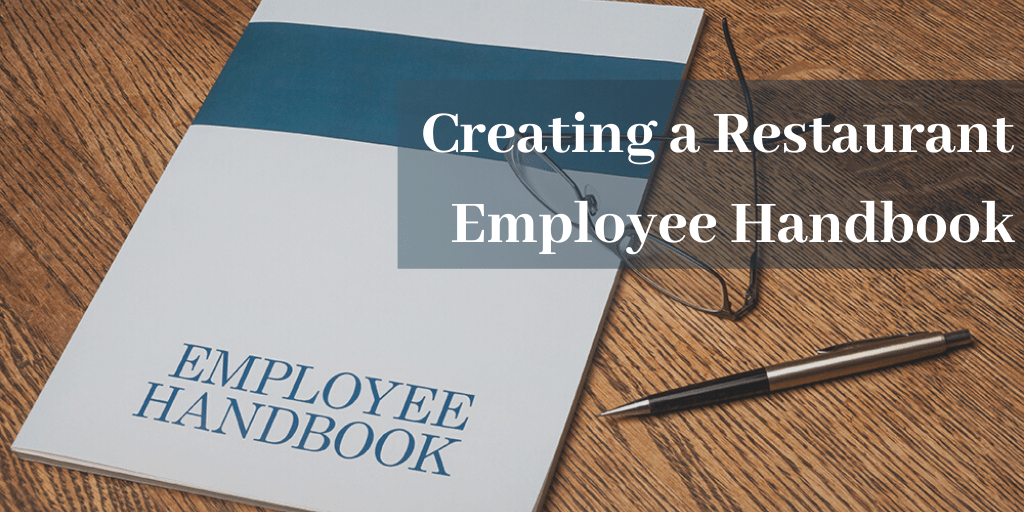A well-crafted employee handbook is absolutely necessary if you want to make your onboarding process run as smoothly as possible.
Whether you’re a small local restaurant or the owner of multiple franchises, every restaurateur wants the same thing: better productivity, increased retention, and happy people.
Without an employee handbook, this will be more difficult to attain.
But exactly how will an employee handbook help? And how can you make one in the first place?
This article will discuss everything you need to know about creating a solid restaurant employee handbook for your business.
Why Do You Need a Restaurant Employee Handbook?
Restaurants are complex.
If you’ve been in the restaurant industry, you know it’s far from just dealing with food. A thriving restaurant means efficient processes, good marketing strategy, stellar customer service, and healthy financial practices – among many other things.
With all these moving parts, it’s a wonder that anything gets done.
But of course, it’s not an easy job. Working in a restaurant, even at the most basic level, requires various skills and knowledge.
Even your newest servers need to learn how to talk to customers, deliver the correct order, and operate various technology just to get through one working day. So lots of time and resources are spent training and upskilling new staff.
The bigger your restaurant, the more skilled labor is needed. This situation means two things:
- It’s inefficient and expensive to have a high turnover rate
- You should continuously improve the quality of training and upskilling
These are the main issues that employee handbooks address on the ground: they serve as your employees’ mutual reference for everything that has to do with their job.
Whether policies, company values, or best practices – it’s simply inefficient to keep repeating the same things again and again to all new hires.
Therefore, an employee handbook is the best solution to pass on this mission-critical information.
What Should You Include in a Restaurant Employee Handbook?
In this section, we’ll talk about the ten important sections you should include in your restaurant employee handbook.
1. Introduction and Welcome Letter
Don’t overthink your introduction. While you should always do your best to make it relevant, and concise, your employees are unlikely to read this handbook cover-to-cover.
However, it’s undeniable that it will structure the rest of the content going forward. It’s also an excellent place for welcome messages and a few other necessary parts of the handbook.
When making an introduction, you have the choice to include any of the following sub-parts.
- Welcome letter. Your employees will feel valued and included with a personal welcome note from owners or general managers.
- History. It’s always a good idea to give tribute to the events that brought your business to where it is today. You can do this with a short story.
- Key takeaways. Provide comprehensive and concise summaries of your brand, values, and operations. If possible, make it so that even if your employees read only this, they’ll still have a general idea of your business.
- Legal disclaimer. Before employees can proceed with the rest of the handbook, you should be clear that it is not a legal contract.
- Table of contents. A clear and comprehensive table of contents will be well-appreciated by everyone, especially since most employees will likely want to skip to pages they feel are most relevant to current concerns.
2. Vision, Missions, and Core Values
When a restaurant has a clear vision, mission, and core values, its daily operations will be guided by those ideals. Every day that your company operates brings you closer to your goals.
Plus, well-defined values also serve as a shared identity that can unite your employees. They are the drivers of engagement, workplace policies, and culture.
Make sure you communicate the importance of these ideals to your employees in an actionable, and accurate manner.
One of the best ways you can do this is by setting it in stone, so to speak. In this case, it means including it in your employee handbook. When your employees are reminded every day of your commitment to your guiding principles, they are more likely to live them.
If you haven’t already, you need to sit down and do a bit of soul-searching.
- Vision. Whether you want to be a dominant name in your local area or a global franchise, your vision tells your customers and employees what kind of future you’re working towards.
Your vision statement answers the question, “What is your ultimate goal?”
- Mission. Your mission statement reveals how you’re working in the present to prepare for the future. Typically, these are shorter-term commitments that show more specific and idealized courses of action.
The mission statement sheds light on the question, “How will you achieve your goals?”
- Core Values. Your restaurant’s core values define the ideals you want to instill in every employee to live out your mission and vision.
Together, they should answer the question, “What characteristics must be central to our people to achieve our goal?”
3. Code of Conduct and Workplace Policies
Typically the thickest portion of the employee handbook, this section contains a well-defined set of rules and best practices regarding multiple different topics.
There could be as many of these rules as you want, although you must keep in mind that they should be clear, actionable, and reasonable.
This part is usually one of the most commonly-consulted areas of the handbook. It would also serve you well to have a good organization, perhaps by inserting a mini table of contents for sub-categories.
Regardless of your handbook organization, you need to ensure that your employees can easily refer to it when a situation arises.
Some of the most common categories that you need to include are:
- General code of conduct. This should include customer treatment, smoking, substance consumption (alcohol, drugs, tobacco), social media and internet use, disciplinary procedures, etc.
- Dress code. Whether you’re a fast-food franchise, a local joint, or a high-end restaurant, your work clothes expectations need to be correctly stated in the handbook.
- General safety policies. This includes health codes, hazard reduction, fire and earthquake drills, etc.
4. Health and Safety Procedures
Although you should have already outlined general health and safety guidelines in the code of conduct, health and safety protocols should have their own subtopic.
This section should contain the rules and best practices that need to be followed to create a safe and healthy workplace. This can include:
- Garbage disposal
- Workplace hygiene protocols
- Essential equipment
- Clean-up guidelines
- Food handling rules
But perhaps one of the essential aspects of health and safety in recent times is the regulations surrounding the Covid-19 pandemic.
As the pandemic necessitated new norms, businesses must also adopt new rules to benefit public health. Your health and safety section needs to have specific provisions about Covid-19, such as the following:
- Social distancing. The official recommendation can vary in different states, but a minimum of 6-feet of space between people needs to be enforced by every indoor establishment.
- Disinfection. Restaurant employees need to disinfect every occupied area after use and maintain multiple handwashing areas on the restaurant floor.
- Mandatory PPE. Employees need to wear fresh masks and gloves at all times. Patrons who come into an indoor establishment must also wear masks as part of the mandatory masking mandate in some states.
- Contact protocols. Every contact area, whether front-facing or backend, must be regularly sanitized with standard products to prevent the spread of the virus.
5. Systems, Operations, and Emergencies
Restaurants now increasingly need complex technology to ensure a certain standard of security, quality, and readiness.
There are multiple systems that a restaurant needs to master to ensure that it can consistently deliver a certain standard of quality and experience, and it’s these things that are often put into the restaurant employee handbook.
Think of this part as a guide for your restaurant’s mission-critical systems. It should include detailed how-tos, responsibilities, and troubleshooting steps to augment the actual training of any restaurant employees who are assigned to those systems.
This section can include the following systems:
- Time management and scheduling. Systems belonging to this category include shift scheduling, meetings, time off requests etc.
- Security. This category deals with securing your restaurant and deterring crime. Thus, these systems should include CCTVs and software services such as Glimpse, which uses computer vision to detect issues in your restaurant.
- Restaurant operations. Systems needed to enhance your restaurant operations are included in this category, such as point of sale systems, online order management, payment processing, and inventory.
More than answering questions or providing basic instructions on operating it, you should also point your staff towards additional resources like your standard operating procedures.
This is because you can’t possibly cover every situation about any system, and your staff might need additional support in a specific case that your handbook doesn’t cover. When this happens, your employees should know where to turn to.
6. Compensation and Benefits
Compensation and benefits are two of the most sought-after things by your restaurant staff, so they’ll naturally want to know more about them.
Being transparent about these factors in your restaurant employee handbook can help you create better rapport with your employees and motivate them to perform at their best. Thus, it would be helpful to include a section specifically discussing this topic.
Compensation Section
Your compensation section should detail the mechanics of your employee’s payments. This includes things such as:
- Expected regular salary for their position
- Policy on overtime work and pay
- Methods of payment (cash, deposit, or check)
- Leave policies, including sick days, holidays, and vacations
- Other policies like break times and early timeouts
Benefits Section
Right next to salary, benefits are also highly sought by your employees, so it would serve them well to know what you’re offering in their specific positions. This can include the following:
- Workers’ compensation. Your employees need to know the mandated insurance that protects them if they get sick or injured on the job, so detail your worker’s compensation policies in this section.
- Healthcare. Benefits that include preventive medical attention (regular checkups, etc.) will be well-appreciated by your employees. This can include dental and vision care, prescription assistance, hospital stays, etc.
- Maternity leave. Maternity leave policies will depend on your local area’s regulations, but the basic standard allows up to 12 weeks of unpaid maternity leave after birth.
- Sponsored events. Christmas parties, get-togethers, and other events give your restaurant staff something fun to look forward to.
Some of these benefits are state-mandated, so you should always consult with a legal or insurance expert to know your obligations as an employer.
On the other hand, benefits that aren’t required by law serve to attract and retain good employees, increasing your efficiency and reducing turnover rates. By detailing these benefits in your employee handbook, you can motivate your employees to perform better.
7. Anti-Harassment and Complaints Policies
As a restaurant owner or manager, your stance against workplace harassment should be well-articulated and transparent in your employee handbook. This includes the many varied forms that harassment may take, such as physical, verbal, or psychological.
When writing the Anti-Harassment and Complaints Policies section of your employee handbook, you need to define what constitutes these behaviors. This means that you have to enumerate the following.
- The behaviors that the restaurant considers harassment
- The exact punishment for those specific behaviors
- A clear, step-by-step action plan for dealing with workplace harassment
While your employees are essential in fostering a healthy work environment, your customers are also a big part of the equation. Thus, you should also include a provision for dealing with customer complaints and resolving conflict.
This means that you need clear guidelines in the following areas:
- Recognizing when a customer is in distress, whether from another customer or otherwise
- Policies for intervention and customer care, such as the Angel Shot program
- Policies for dealing with grievances and conflict resolution
8. Training and Development
Career development is one factor that goes hand with high retention rates; the more you invest in your employees, the less likely they are to take off.
While your employees might be happy to work for you now, just like you, they also have their future in mind. If they see themselves growing with the company, they’re more likely to stick with you.
Therefore, it’s beneficial to include your training and development plans in your employee handbook, so your employees will know what you have to offer for their future.
There are also different kinds of training that you can include in your training and development plan, such as the following:
- Employee onboarding. This section should discuss what your employee can expect in training about your restaurant’s current processes. This could be things like formal lessons, mentorships, etc.
- Sensitivity and awareness seminars. Workplaces are becoming more diverse and dynamic, and your employees need the training to catch up with new trends. Things like mental health awareness, diversity training, cultural sensitivity, team building activities, etc., will be well-appreciated and contribute to creating a healthy work environment.
- Upskilling and career options. Depending on your employee’s performance reviews, you can invest in developing talented workers for higher positions in the future.
9. Frequently Asked Questions
One of the last things you need to add to your restaurant employee handbook is the FAQ section.
You can create this section by compiling the most common questions that past employees asked about their jobs and the restaurant. This section can contain quick solutions or direct them to the right resource to get more detailed answers.
There are many ways you can provide support, such as through the following.
- A mentor or workplace buddy
- Workplace group chats
- Help centers
- Specific knowledge hubs for any kind of software service
- Instruction manuals for equipment and tools
- Your restaurant’s administration or HR department
10. Wrap-Up and Employee Signatures
This section of your manual will wrap everything up nicely, giving it a definite conclusion.
Aside from a few concluding statements and welcome messages, you can also insert reminders, key point summaries, and even a glossary of terms to make the handbook easier to use.
Lastly, include a space for your employees to affix their signature with a date. This further reinforces their employment’s finality and demonstrates that they’ve read and understood your policies.
Although your handbook is not legally-binding, this section will reinforce compliance with the handbook’s contents.
Creating a Restaurant Employee Handbook in 2022 and Beyond
A reliable and high-quality employee handbook that your employees can consult when needed is critical to help further their training and improve retention in the process.
Whether you’re creating a new employee handbook for your restaurant or updating your old one to match new regulations in the hospitality industry, we hope this article will serve as a trusted guide on the contents of your employee handbook.









 +1 (786) 292-2373
+1 (786) 292-2373 insights@glimpsecorp.com
insights@glimpsecorp.com





